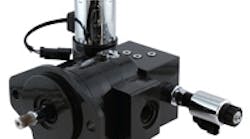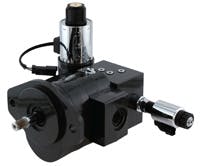Hydraulic fan drives continue to exhibit expanded application in off-highway equipment. A key to the success of hydraulic fan drives is that fan speed can be controlled simply by regulating the hydraulic pressure of the motor that drives the fan. Controlling fan speed allows precise cooling to keep a diesel engine operating near its optimum temperature for high fuel economy and low emissions.
Variable-speed hydraulic fan drives not only operate the diesel engine at an efficient temperature — which is essential for machine builders working toward Tier IV compliance — but offer other advantages. For example, not driving the fan from the engine allows placing the radiator assembly in a location where it can draw in cool, clean air. Furthermore, if the radiator should become clogged with dirt, the hydraulic motor can be reversed to blow debris out of the radiator.
The main components of a hydraulic fan drive include a variety of sensors, an electronic control, hydraulic pump, pressure-control valve, and, of course, the hydraulic motor. For cooling systems with a maximum power rating below 50 hp, gear motors are usually specified because they are compact and light weight; can easily provide the rotational power to drive the fan through a wide range of speeds; and are relatively inexpensive. (Piston pumps usually get the nod for systems requiring higher power because their higher efficiency can quickly pay for their higher price tag.)
Answering the call
In response to the growth of gear motors used in fan drives, Sauer-Danfoss, Ames, Iowa, offers its D series cast iron gear motor with an integrated valve to match fan speed to cooling demand. It also features reversible rotation for radiator cleaning.
According to Misty Metschke, Gear Products Project Manager for Sauer-Danfoss, “Global emissions standards require cooling systems to become more advanced. Vehicle systems will reject more heat, requiring fans to run longer and more often. Our goal is to [provide] solutions that maximize machine performance without sacrificing compactness, durability, and total installed cost.”
The D series motor offers the pressure, temperature, and radial load capabilities of a piston motor with the compact size, contamination resistance and cost advantages of a gear motor. The cast iron construction exceeds capabilities of traditional aluminum motors in applications requiring higher pressures, temperatures, and duty cycles.
Metschke says the D series is the only cast iron fan drive motor on the market with an integrated reversing feature. “With the new reversing feature,” Metschke says, “we built upon the high-efficiency design of the D series motor and will continue to focus on increased performance, durability, and installation flexibility.”
Design benefits
The reversing function integrates a solenoid operated directional control valve to reverse fan rotation and a proportional relief valve to regulate fan speed. These valves come in two flow ranges. Dual shock/anti-cavitation valves limit pressure spikes during sudden reversals and allow flow to bypass the motor as the fan decelerates. The motor comes in displacements from 14 to 45 cc and features pressure balanced thrust plates to maintain efficiency up to rated pressure (276 bar) and temperature (110 °C).
Heavy-duty bearings provide high load capacity and eliminate the need for an external bearing. Compact design makes the D series motor 20% smaller than a conventional motor. The shorter length and consequent high power density ease installation in tight spaces. “It’s the most power-dense fan drive motor on the market today,” Metschke says. The integrated valve design eliminates the need for extra hoses, fittings, and assembly labor.
The D series motor is fully compatible with the PLUS+1 system, ensuring seamless integration with microcontrollers and other Sauer Danfoss products, including sensors, joysticks, and graphical display terminals.
For more information, contact Misty Metschke at (515) 239-6500, e-mail [email protected], or visit www.sauer-danfoss.com.


